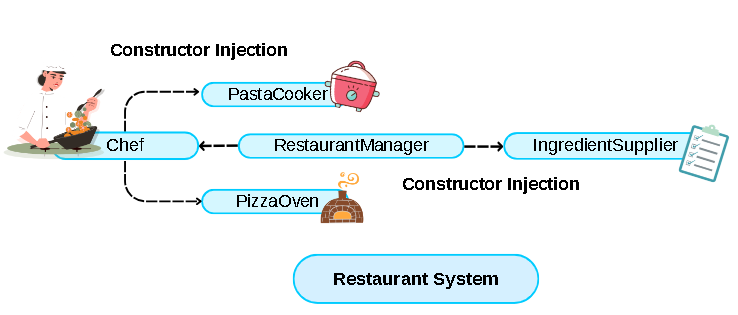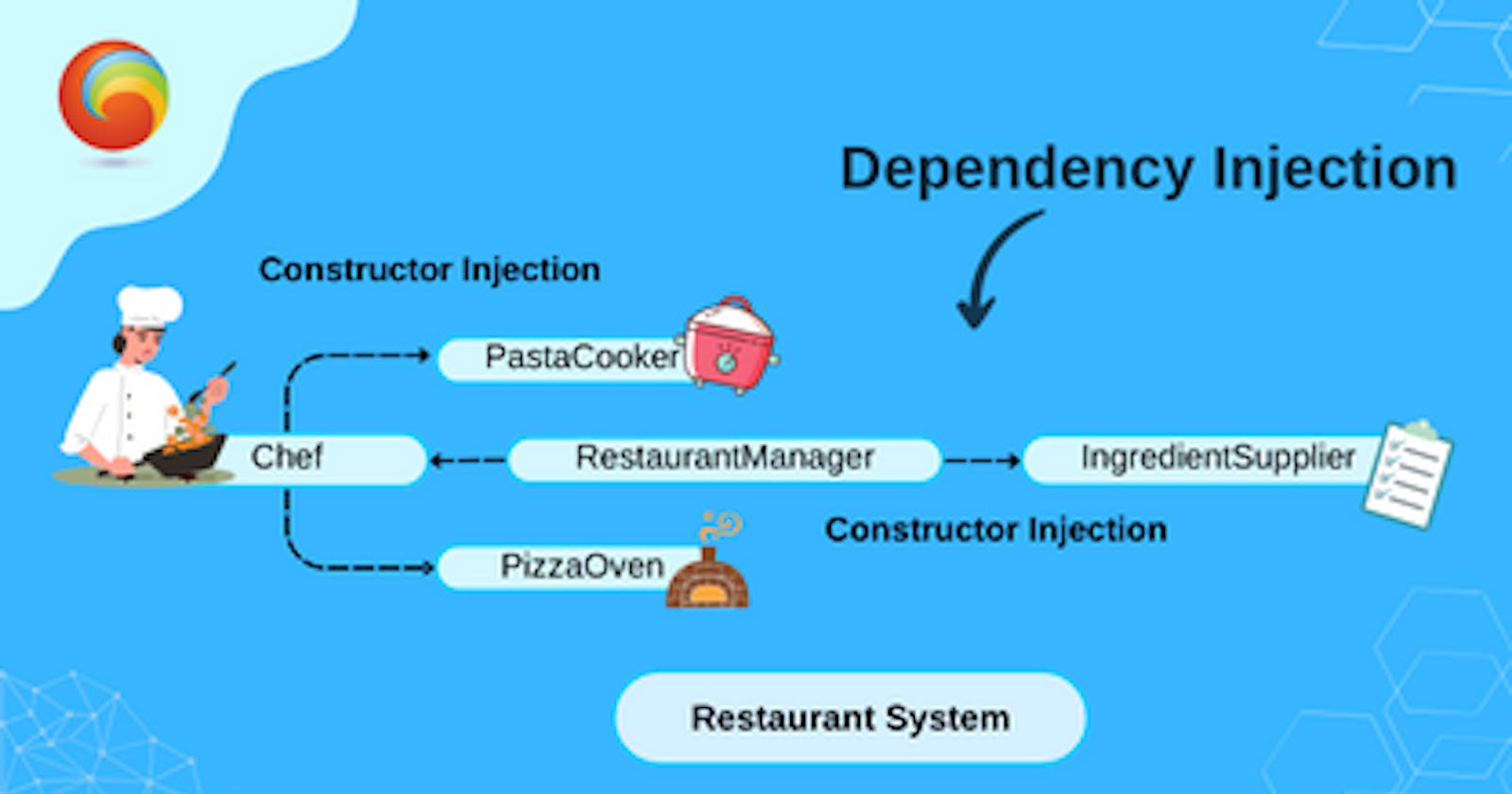Introduction
In the world of software development, there's a powerful concept called Dependency Injection (DI) that can make your coding life a lot easier. In this article, we'll demystify DI with real-world examples, making it simple to understand.
What is Dependency Injection?
Dependency Injection (DI) is a design pattern that helps you write clean, organized, and testable code. At its core, DI is about providing the necessary building blocks (dependencies) to your code instead of having it create them itself.
Real-World Analogy: The Great Restaurant
To understand DI, let's imagine we own "The Great Restaurant." We serve various dishes, and our chef, Bob, is responsible for cooking. Bob needs tools and ingredients to create his culinary masterpieces, and these are his dependencies.

Classic Restaurant Approach
In a non-DI scenario, our code might look like this:
// non-DI scenario
class Chef {
public void CookPasta {
PastaCooker pastaCooker = new PastaCooker();
pastaCooker.Cook();
}
public void MakePizza {
PizzaOven pizzaOven = new PizzaOven();
pizzaOven.Bake();
}
}
This code creates new instances of cooking tools (PastaCooker, PizzaOven) within the Chef class. It tightly couples the Chef to these tools, making it challenging to change or test them independently.
Introducing Dependency Injection
Now, let's apply DI to our restaurant:
// DI scenario
class Chef {
private PastaCooker pastaCooker;
private PizzaOven pizzaOven;
public Chef(PastaCooker pastaCooker, PizzaOven pizzaOven) {
this.pastaCooker = pastaCooker;
this.pizzaOven = pizzaOven;
}
public void CookPasta {
pastaCooker.Cook();
}
public void MakePizza {
pizzaOven.Bake();
}
}
In this improved version, Chef's dependencies (pastaCooker and pizzaOven) are provided through the constructor. This decouples the Chef class from its tools, making it more adaptable.
Benefits of Dependency Injection
Improved Testability: With DI, we can easily replace real dependencies with test versions, enabling us to test Chef's cooking skills without actually cooking food.
Flexibility: We can change cooking tools without modifying the Chef class. If we upgrade to a new pasta cooker, we just inject the new instance.
Easier Maintenance: Changes in the PastaCooker or PizzaOven don't affect the Chef class. Modifications are isolated within their respective classes.
Real-World Expansion: The Restaurant Manager
To further illustrate the importance of DI, let's introduce a new character in our restaurant: the Restaurant Manager, Lisa. Lisa is responsible for ordering ingredients and managing the kitchen.
In a classic, non-DI approach:
// non-DI scenario
class RestaurantManager {
public void OrderIngredients {
IngredientSupplier supplier = new IngredientSupplier();
supplier.DeliverIngredients();
}
public void ManageKitchen {
Chef chef = new Chef();
chef.CookPasta();
chef.MakePizza();
}
}
Here, we create new instances of IngredientSupplier and Chef within the RestaurantManager class. Like the previous example, this tightly couples Lisa to her dependencies.
Introducing Dependency Injection
Now, let's see how Dependency Injection can enhance the RestaurantManager:
// DI scenario
class RestaurantManager {
private IngredientSupplier supplier;
private Chef chef;
public RestaurantManager(IngredientSupplier supplier, Chef chef) {
this.supplier = supplier;
this.chef = chef;
}
public void OrderIngredients {
supplier.DeliverIngredients();
}
public void ManageKitchen {
chef.CookPasta();
chef.MakePizza();
}
}
In this version, Lisa's dependencies (IngredientSupplier and Chef) are injected through the constructor, decoupling her from these components.
Conclusion:
Dependency Injection is like providing the right tools and ingredients to your chef to create delicious dishes. It promotes modularity, testability, and maintainability in your code. By embracing this pattern, you can cook up software that's easier to develop, understand, and maintain.
So, the next time you hear about Dependency Injection, think of your favorite restaurant and how they smoothly serve up your favorite dishes, one plate at a time. In the coding world, it's all about serving up a better development experience, one line of code at a time.
Thank you for reading!
Frequently Asked Questions
What are the types of dependency injection?
There are three common types of dependency injection:
Constructor Injection:
In this type, dependencies are injected through the constructor of the dependent class. It is the most common and recommended type, ensuring that the required dependencies are available when an object is created.
Setter Injection:
Dependencies are injected through setter methods of the dependent class. Setter injection allows for more flexibility in changing dependencies after the object has been created.
Method Injection:
Dependencies are injected through methods of the dependent class when needed. This type is less common and used when specific methods require certain dependencies.
Where is dependency injection used?
- Dependency injection is used in enterprise applications, web development (e.g., Spring, Angular), mobile app development (e.g., Android, iOS), testing environments, and frameworks/libraries to enhance modularity.
How does dependency injection work in Spring?
- In Spring, dependency injection is achieved through an IoC container. Dependencies are configured in XML, JavaConfig, or annotated classes. The container manages object creation, assembles them, and injects dependencies using a constructor, setter, or method injection.
What does dependency injection result in?
Dependency injection results in decoupling components, improving testability, maintaining a clean codebase, increasing flexibility, and enhancing code readability. It promotes modular and adaptable software design.

